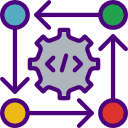Low-code development has experienced a dynamic evolution in recent years, rapidly transforming how businesses approach software creation and digital transformation. As organizations seek greater agility, collaboration, and efficiency, low-code platforms are at the forefront, enabling both professional developers and citizen developers to build applications with minimal coding expertise. The latest trends in low-code development tools reveal a powerful convergence of automation, artificial intelligence, seamless integration, and enhanced governance, all designed to meet the growing demands of modern enterprises.
Expanding Automation Capabilities
One of the notable shifts in low-code platforms is their integration of intelligent workflow automation. Tools now offer drag-and-drop interfaces that let users connect various systems and define automated processes, ranging from simple notifications to intricate multi-step business logic. This democratizes access to powerful orchestration, letting non-technical stakeholders contribute to process optimization. The infusion of AI-driven logic and conditional triggers further enhances these workflows, making them adaptive and responsive to real-time data. As a result, organizations rapidly achieve operational efficiencies that would have traditionally required extensive manual coding or dedicated RPA solutions.

API-First Development Paradigm
A prominent trend in low-code platforms is the adoption of an API-first approach. With this strategy, platforms provide pre-built connectors and easy configuration wizards for a vast array of third-party services, databases, and internal tools. This empowers users to rapidly assemble applications that leverage data and functionality from across their organization’s ecosystem. API documentation and maintenance are often automated, further simplifying integration. The result is a significant reduction in the time and complexity required to create composite applications, while ensuring interoperability and future scalability.
Seamless Legacy System Integration
Many enterprises still rely on critical legacy infrastructure, which poses unique challenges for modernization. Recent advancements in low-code tools address this reality directly, offering sophisticated connectors and middleware for older systems such as mainframes and on-premise databases. These connections require little to no custom code, making it feasible to modernize workflows and interfaces without disrupting core operations. Such capabilities accelerate digital transformation initiatives, preserve valuable investments in legacy systems, and extend their usability in a cloud-first world.
Cross-Platform Data Synchronization
Organizations increasingly require real-time, reliable data flows between disparate platforms. Low-code tools now feature advanced data synchronization modules, enabling applications to share and update information seamlessly across environments. These modules can handle complex data transformations and maintain consistency whether data resides in cloud, on-premises, or hybrid storage. As these synchronization features become more powerful and user-friendly, businesses can ensure accuracy in reporting, support advanced analytics, and unlock unified customer or operational views with minimal technical overhead.

AI-Driven Development Features
Recent low-code tools are employing AI algorithms to automatically generate application logic, user interfaces, and even complex business rules based on plain language descriptions or user actions. Developers and business users can describe desired functionality in natural language, and the platform translates that into working application components. This not only accelerates prototyping but also reduces the learning curve for non-technical users. The ability to refine and expand generated components through AI suggestions further streamlines the development process, encouraging experimentation and iterative design.
Join our mailing list
